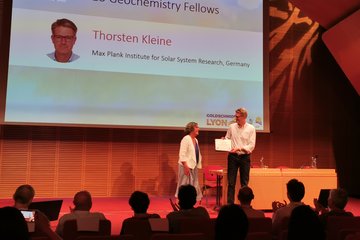Alle Typen
21.
Zeitschriftenartikel
Saturation and time dependence of geodynamo models. Geophysical Journal International 182, S. 675 - 681 (2010)
22.
Zeitschriftenartikel
An efficient method for computing the eigenfunctions of the dynamo equation. Astronomy and Astrophysics 519, A80 (2010)
23.
Zeitschriftenartikel
Planetary dynamos from a solar perspective. Space Science Reviews 144 (1-4), S. 105 - 126 (2009)
24.
Zeitschriftenartikel
Countercell Meridional Flow and Latitudinal Distribution of the Solar Polar Magnetic Field. Astrophysical Journal 693, S. L96 - L99 (2009)
25.
Zeitschriftenartikel
Modelling of solar mesogranulation. Astronomy and Astrophysics 504, S. 1041 - 1055 (2009)
26.
Zeitschriftenartikel
Der Aktivitätszyklus der Sonne. Astronomie + Raumfahrt 46(6), S. 28 - 31 (2009)
27.
Zeitschriftenartikel
Moments of the latitudinal dependence of the sunspot cycle: A new diagnostic of dynamo models. Astronomy and Astrophysics 483, S. 623 - 632 (2008)
28.
Zeitschriftenartikel
Flow instabilities of magnetic flux tubes - II. Longitudinal flow. Astronomy and Astrophysics 469, S. 11 - 17 (2007)
29.
Zeitschriftenartikel
A coupled model of magnetic flux generation and transport in stars. Astron. Nachrichten 328, S. 1111 - 1113 (2007)
30.
Zeitschriftenartikel
Mean-field concept and direct numerical simulations of rotating magnetoconvection and the geodynamo. Geophys. Astrophys. Fluid Dynamics 101, S. 81 - 116 (2007)
31.
Zeitschriftenartikel
A necessary extension of the surface flux transport model. Astronomy and Astrophysics 446, S. 307 - 314 (2006)
32.
Zeitschriftenartikel
Mean-field view on geodynamo models. Magnetohydrodynamics 42, S. 111 - 122 (2006)
33.
Zeitschriftenartikel
A necessary extension of the flux transport model. Memorie della Societa Astronomica Italiana 76, S. 933 - 936 (2005)
34.
Zeitschriftenartikel
Stochastic resonance in a bistable geodynamo model. Astron. Nachrichten 326, S. 227 - 230 (2005)
35.
Zeitschriftenartikel
Origin of solar magnetic variability. Memorie della Societa Astronomica Italiana 76, S. 773 - 780 (2005)
36.
Zeitschriftenartikel
Mean-field view on rotating magnetoconvection and a geodynamo model. Astron. Nachrichten 326, S. 245 - 249 (2005)
37.
Zeitschriftenartikel
Evolution of the large-scale magnetic field on the solar surface: a parameter study. Astronomy and Astrophysics 426, S. 1075 - 1091 (2004)
38.
Zeitschriftenartikel
Kelvin-Helmholtz and shear instability of a helical flow around a magnetic flux tube. Astronomy and Astrophysics 420 (2), S. 737 - 749 (2004)
39.
Zeitschriftenartikel
Does the butterfly diagram indicate a solar flux-transport dynamo? Astronomy and Astrophysics 421, S. 349 - 351 (2004)
40.
Zeitschriftenartikel
A theoretical analysis of the observed variability of the geomagnetic dipole field. Physics of the Earth and Planetary Interiors 130, S. 143 - 157 (2002)











